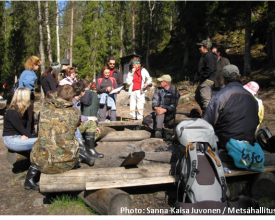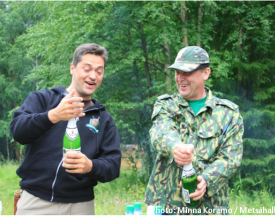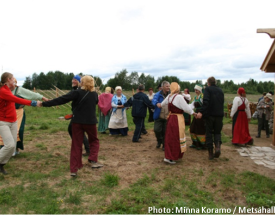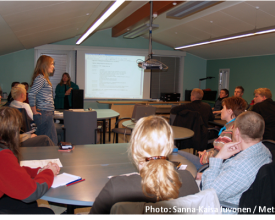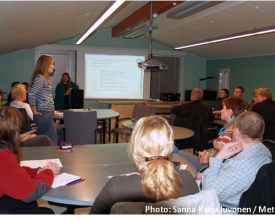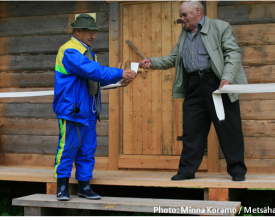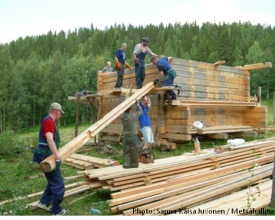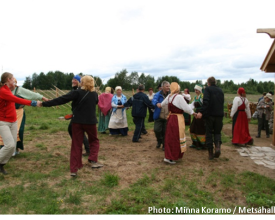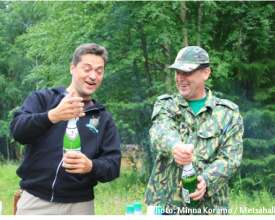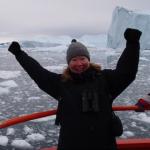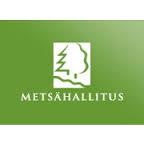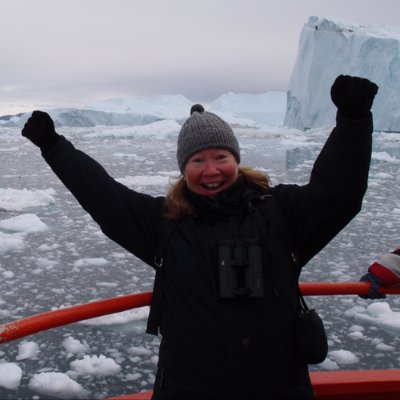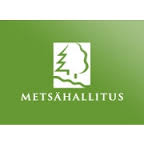
Enhancing Sustainability and Cooperation in Transboundary National Parks
Full Solution
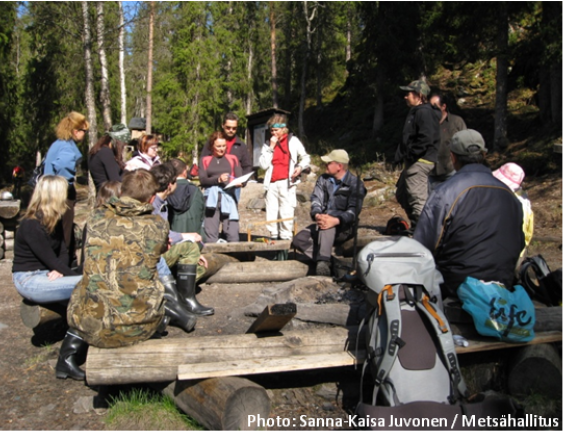
Finnish and Russian scientists and park staff talking about ecological sustainability in Oulanka National Park, Finland.
Sanna-Kaisa Juvonen / Metsähallitus Parks & Wildlife Finland
Cooperation in transboundary National Parks (NPs) Oulanka in Finland and Paanajärvi in Russia was strengthened through implementation of a joint cross-border project that enabled the personnel of the NPs to work closely together in hands-on activities. The activities made the common history come to life, which helped in leaving behind past grievances through achievement of common goals and enhancing sustainable tourism within the Oulanka-Paanajärvi twin park.
Context
Challenges addressed
na
Nature knows no borders, so ensuring transboundary management of NPs enhances ecological sustainability regionally. Needs for enhanced sustainable tourism through interpretation of natural and cultural sites by quality guides motivated this Solution. Addressing these challenges is fundamental to promote nature tourism, regional appeal, continued recreational use, and gain champions for NPs.
Beneficiaries
Nature and culture tourism businesses; Tourism associations and development organizations; North-Eastern Finland, District of Loukhi, Russia; Research, education and interpretation organisations; and Oulanka and Paanajärvi National Park management
Location
Oulanka National Park, Finland
North and Central Asia
North Europe
Process
Summary of the process
Enhancing ecological sustainability and cooperation in transboundary NPs Oulanka in Finland and Paanajärvi in Russia was done through implementation of a joint project (Building Block 4) that enabled the personnel of the NPs to work closely together in hands-on activities across the border (BBs 1-4). Sustainability of nature tourism and recreational use of nature in NPs was enhanced through channeling of visitor use (BB 2), training and certification of nature tourism guides (BB 3), assessment of sustainability of current actions (BB 4). Furthermore, cultural sites were reconstructed (BB 5) to improve knowledge of the past and shared history in order to promote peace, mutual understanding, learning and continued transboundary cooperation (e.g., BB 4) in modern times.
Building Blocks
Development of GIS-based electronic information points
The aim of the electronic information points is channeling visitor use in order to help avoid congestion within Paanajärvi and Oulanka NPs and thus to enhance possibilities of nature experiences for visitors and to safeguard biological diversity and ecological sustainability of the NPs. Through the information points visitors can obtain easily accessible, fun and entertaining information of the possibilities for experiencing nature in Oulanka and Paanajärvi National Parks and in other areas in their vicinity, encouraging also visitation across the border. The information points also describe less visited sites, thus channelling the visitor use towards areas that can accommodate more visitors. This can effectively reduce crowding in certain areas and thus contribute towards preserving ecological values in the more crowded areas.
Nine electronic, multi-lingual information points were installed: 7 in Finland and 2 in Russia. Partnerships were formed with tourism associations and businesses and local administrations in order to place the information points in well visited sites outside of National Parks, as well as in the Visitor Centres of the NPs. Emphasis was put on presenting the sites with engaging photos and fun text.
Enabling factors
There was great interest in these electronic information points, and the managers of sites where information points were placed were keen to maintain them.
Interest of regional and local authorities and tourism sector actors to promote natural and cultural sites of visit within their own and in neighbouring areas was important for planning and implementing the information points. The personnel of the National Parks were keen to share their photos for the information points and the Parks management was very supportive of the information points.
Lesson learned
The electronic information points provide information in a fun and entertaining way focusing more on photos than text. By keeping the text short and fun to read along with photos showing people not taking themselves seriously, the information is easily accessible to the user.
The electronic information points can be updated using a network connection but they cannot be used over the Internet. They are only available on site. It might be worth to have the information points available on the Internet as well, as that is the way people seek information nowadays. This would help visitors plan their trip better and avoid crowds as they could find information on the less visited and known sites prior to their visit.
Training and certification of National Park guides
A competent guide and site-specific information deepen the visitor experience and understanding of natural and cultural sites. There is a need for increased quality in the range of nature-based tourism products and guides specialised in sites and site-specific information to intensify the visitor’s experience. The project answered to this challenge by developing a training system for nature guides as well as the principles governing the certification of guides for Oulanka National Park in Finland.
Four guides from the Russian Paanajärvi National Park participated in the training course for nature guides in order to learn about the training and its applicability in Paanajärvi NP and to enhance their knowledge of Oulanka NP as well as to form personal links with Oulanka NP staff. Other participants of the training were guides of local nature-based tourism businesses. In order to be certified, the guides had to pass the tasks specified in the training programme. The training was given by NP specialists and practical arrangements were organised by a co-operating educational institute.
Enabling factors
The interest of the local nature-based tourism businesses to have their guides participate in the training course was the most fundamental factor. This meant that the businesses were willing to invest in their guides, as they believed it would ultimately be beneficial for the business. The National Park’s willingness to provide resources (staff and funding) for the training was of vital importance. Open and constructive dialogue between NP management and businesses was very important during the training.
Lesson learned
The training was a great way to get to know the local nature-based tourism businesses and the people that work in them. We (managers of National Parks) learned about the realities of business, while the business entrepreneurs learned about our management philosophy and got to know us personally. After the training, the entrepreneurs saw us as actual people rather than just authorities enforcing laws. This helped improve relationships between NP managers and the entrepreneurs.
During the training, it is important to have time for discussions and sharing as these strengthen the bonds between people. It is very important to do the training on the guides’ terms: they are used to oral presentation, not written, so it is good to formulate the tasks so that not much paper work is needed on the trainees’ part. It is good to make the certified guides public and give them the right to use a certified guide badge. It is vital to take into account the tourist season and avoid training during it.
Enhancing sustainable tourism in transboundary NPs
Nature is the basis for nature-oriented tourism and recreational use of nature, thus nature tourism must be sustainable: not threatening natural values and respecting local culture. Sustainability of activities is a precondition for use of NPs, continuity of nature-based tourism and recreational use of nature, and regional attractiveness.
Assessments of ecological sustainability of tourism and recreational use of nature were conducted in Oulanka and Paanajärvi NPs by research institutions. The method ‘Limits of Acceptable Change’ was used to determine limits of ecological sustainability as part of a Sustainable Tourism Development Strategy in Oulanka NP. Waste management practices and public awareness of waste management were developed in Paanajärvi NP. A Sustainable Tourism Development Strategy (STDS) was developed in Paanajärvi NP to match the already existing one in Oulanka NP. The STDS is an instrument for attaining long-term sustainability of ecological and socio-economic development of the territory. Work on STDS enables an objective assessment of the present situation of the transboundary NPs and adjoining areas in relation to development of tourism and to develop a plan of future activities for the whole territory.
Enabling factors
It was important that there was sufficient data collected on natural and socio-economic conditions of the National Parks in order to make an educated assessment of the sustainability of nature-based tourism and recreational use of nature. Good cooperation with stakeholders that have an impact on National Parks was vital as was mutual commitment to the importance of strategic planning of the Parks and their surrounding area. Monitoring of the factors used to determine the limits of acceptable change is essential for long-term sustainability.
Lesson learned
It is important to reserve sufficient time to build the base for cooperation and understanding of the methodology and process of developing a Sustainable Tourism Development Strategy for a National Park. It is also important to engage the stakeholders early on so that they feel that their views and opinions are taken into account. This enhances the commitment to implement the STDS by all involved.
Collection of baseline data and information and monitoring of relevant factors is essential if real sustainability in the use of National Parks is to be reached. Also the limits of acceptable change should be open for revision as new data are collected. Sharing of work methodologies and information across the border in transboundary NPs improves coordinated actions that benefit NPs on both sides of the border, thus also making the management of transboundary NPs more in line. This transboundary cooperation is essential to ensure ecological sustainability, as nature knows no borders.
Sharing a common past through preservation of cultural sites
The aim of this activity was preservation of cultural sites and promotion of cultural tourism through reconstruction of buildings and production of information in order to improve knowledge of the past in Paanajärvi National Park in Russia. The border area was ravaged in past wars and the border shifted leaving parts of what is now Paanajärvi NP that belonged to Finland on the Russian side. Through understanding of the past we can learn from it and promote peace and cooperation in our time.
Two buildings were constructed using an old building technique for log houses after models from the 1930s in the old Finnish settlement of Arola in Paanajärvi NP (now part of Russia) and one in the old Russian Karelian village of Vartiolampi. Information panels about the history of these sites were placed in the vicinity of the buildings and an exhibition of historical objects was set up in the building in Vartiolampi. Also history books were produced in order to highlight that the NPs share common roots and want to share a common future as well.
Enabling factors
It was crucial that there were craftsmen that could build with an old building technique. They gave capacity building to younger craftsmen and skills were also exchanged across the border. It was essential that the management of both Oulanka and Paanajärvi NPs were interested in promotion of cultural tourism and preservation of cultural sites in areas that are more known for their wilderness character.
Lesson learned
It is important to collect stories from people when cultural heritage sites are to be interpreted as they make the sites alive. We took former inhabitants of the old Finnish settlements (now in Russia) to visit the reconstructed Finnish site and that was an emotional journey for them. Also it was a great learning experience for us. It is good to involve people that have ties to the cultural heritage sites in the heritage interpretation of the site.
When reconstructing buildings it is important to have them as historically accurate as possible and using appropriate old techniques. It is also important to tell the visitor that the buildings are reconstructions, not historical ones.
Even if it might be painful to dig into past that is not always peaceful and harmonious, it is good to tell about this to the visitors in order to make them realize that we can learn from the past. Work in transboundary NPs teaches us that we can work together with a common goal even with a shared darker past.
Strengthening transboundary cooperation through joint action
For transboundary cooperation to work, it is important that the transboundary National Parks work together on common tasks and activities. This can be achieved through joint implementation of projects. In the case of Oulanka National Park in Finland and Paanajärvi National Park in Russia, many projects have been implemented in order to solidify these two entities into one real functional unit – a twin park – that serves as a model for transboundary cooperation.
The Interreg/Tacis Joint Project “Oulanka-Paanajärvi – wilderness, experiences and well-being” contributed toward ensuring ecological and socio-economic sustainability of Oulanka and Paanajärvi National Parks while preserving and enhancing attractiveness of the region for visitors and to make the twin park the most important and attractive destination for nature-oriented tourism in the region. This in turn creates possibilities for entrepreneurship and preserves and strengthens employment opportunities for local people and entrepreneurs.
Joint management and implementation of the project was an important tool in making transboundary cooperation part of the daily work in the management of the transboundary National Parks on both sides of the border.
Enabling factors
It is helpful if transboundary cooperation has recognition on a higher level than just the National Parks. In Oulanka-Paanajärvi twin park, in addition to the joint agreement of collaboration there is a convention between the Finnish and Russian governments as well as a memorandum between the regional governments. The commitment of twin park managers and personnel to reaching common goals and working together is essential. Promotion on both sides is important and helps nature tourism businesses in creating sustainable transboundary products.
Lesson learned
The best way to make transboundary work part of daily activities of managers and personnel of the National Parks is to do actual work together and in such a way that all levels of personnel participate in the work. Transboundary work cannot be just meetings between higher level staff but actual hands-on work by all levels of personnel.
It is important that the staff members that have knowledge of the language spoken in the NP across the border or another common language actively act as interpreters in order to help communication between personnel in transboundary NPs. Language learning should be encouraged and supported by the management of NPs.
It is also important to celebrate the achievements together and invite local people, businesses, local and regional government and media to take part in the events. It is important to make new history together especially in Oulanka-Paanajärvi region where wars were fought and the border was closed for a long time.
Impacts
1. Limits of Acceptable Change methodology was taken into practice in Oulanka National Park in order to guarantee sustainable tourism and recreation within the NP. Sustainable Tourism Development Strategy for Paanajärvi National Park was developed, which strengthened the ecological and socio-economic sustainability of the NP and cooperation between tourism sector, NP and other stakeholders. Sustainable tourism practices were standardized in the Oulanka-Paanajärvi twin park. Channeling of visitor use to decrease risk of overcrowding and disturbance in ecologically sensitive areas in the National Parks was improved. Waste management of Paanajärvi NP was developed, strengthening ecological sustainability of the NP.
2. Nature interpretation and visitor guidance practices and methods/effectiveness of communication on nature-oriented tourism and cultural heritage were strengthened enabling better understanding and interpretation of natural and cultural significance of Oulanka and Paanajärvi National Parks and their shared common history. Sense of common history and future was strengthened.
3. Personal contacts between NPs increased and management unified through implementation of joint action. Commitment to joint work increased.
Story
Finland and Russia are old enemies, we cannot deny that. Fortunately, countries have nowadays other kinds of ties to each other. Now, many grassroots organisations are working together across the border. Oulanka National Park in Finland and Paanajärvi National Park in Russia have cooperated since the establishment of Paanajärvi NP in 1992. The National Parks are physically connected across the border by extensive taiga and a river that runs from Oulanka to Paanajärvi. They are also connected by shared history. For centuries the border between Finland and Russia in Paanajärvi area has shifted alternately eastward and westward. Before World War II, Paanajärvi belonged almost entirely to Finland. In the western end of Lake Paanajärvi, there was the busiest village of the region that was also the hub of tourism. Then the war started and wiped away the settlements. Paanajärvi area became wilderness where nature took back old pastures and fields.
In recent years, Oulanka and Paanajärvi NPs have emphasised not just a shared nature but also a shared history and culture in order to remember the past – not with a grudge but with fondness and a learning spirit. When we officially opened the reconstructed buildings in Paanajärvi, we had with us two gentlemen, Mr. Eero Manninen and Mr. Pauli Hietala, that had lived in Paanajärvi area before the war. They were overjoyed that they could visit once again their old stomping grounds and reminisce of the old days with a hint of melancholy but without bitterness. We took Mr. Manninen also to see his parents’ grave that remained on the Russian side after the war. This was the last time he had a chance to see them. The gentlemen could have been bitter but they were not and gave us all an example how not to forget but to forgive.
Nowadays cooperation between the NPs is very strong. The NPs support visits of schoolchildren to neighbouring country in order to teach them the meaning of cooperation and to give them a chance to learn about nature and life across the border. To maintain peace in the world today we need to forge relationships with our neighbours and transboundary cooperation is one great way to do that.
Connect with contributors
Other contributors
Sanna-Kaisa Juvonen
Metsähallitus, Parks & Wildlife Finland, Vantaa, Finland
Brady J. Mattsson
Institute of Silviculture, University of Natural Resources & Life Sciences, Vienna

